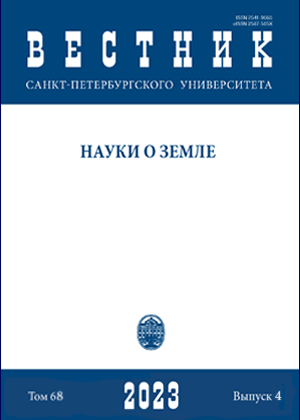Dependence of bioavailability of lead compounds in soils on the type and source of contamination (the example of Mexico City and mining area of Parral, Mexico)
DOI:
https://doi.org/10.21638/spbu07.2023.408Abstract
Evaluation and monitoring of soil contamination with heavy metals relies in most cases on their bulk concentrations whereas the risks of negative effects on human health depend upon the content of their bioavailable forms. The paper presents the study of the dependence of lead bioavailability in the surface soil horizons upon the contamination type and source. Two territories in Mexico with sharp difference of the source of pollution: Mexico City megapolis where the lead in soils originates from the ethyl gasoline burning and mining district in the south of Chihuahua State where the mine tailings are the source of the toxic elements including lead. Bulk lead concentrations were measured by the X-ray fluorescence method, bioavailability was estimated by the method imitating the effect of the stomach and intestine solutions. The research has shown that both in Mexico City (especially in its central part) and in the mining district in the Chihuahua State bulk lead concentrations are several times higher than the background values. The soils of the mining district have average bulk lead concentrations 787,5 mg/kg and show the average bioavailability values 64% whereas in the Mexico City megapolis average bulk concentrations of lead are lower - 324,7 mg/kg but bioavailability reaches 83% and in some samples even 100%. These results support the conclusion that despite lower bulk lead concentrations in Mexico City the risk of its negative effect on humans is higher than in the mining district polluted with the wastes of mining industry. The explanation of the observed tendency is that the chemical form of lead has a major influence on its bioavailability. Dependence of bioavailability upon the bulk concentrations within each study territory has not been established.
Keywords:
bioavailability, bulk concentration, contamination, lead, Mexico
Downloads
References
Быков, А. А. и Ревич, Б. А. (2001). Оценка риска загрязнения окружающей среды свинцом для здоровья детей в России. М.: Мир.
Водяницкий, Ю. Н. (2008). Тяжелые металлы и металлоиды в почвах. М.: Почвенный ин-т им. В. В. Докучаева РАСХН.
Водяницкий, Ю. Н. (2012). Нормативы содержания тяжелых металлов и металлоидов в почвах. Почвоведение, 3, 368-375.
Водяницкий, Ю. Н. и Яковлев, А. С. (2011). Оценка загрязнения почвы по содержанию тяжелых металлов в профиле. Почвоведение, 3, 329-335.
Гордеева, О. Н., Белоголова, Б. А., Гребенщикова, В. И. (2010). Распределение и миграция тяжелых металлов и мышьяка в системе «почва - растение» в условиях г. Свирска (Южное Прибайкалье). Проблемы региональной экологии, 3, 108-113.
Зубков, Н. В. и Зубкова, В. М. (2013). Известкование почвы, загрязненной тяжелыми металлами, и элементный состав растений. Вестник МГПУ. Серия: Естественные науки, 12 (2), 79-90.
Кузнецов, В. А. и Шимко, Г. А. (1990). Метод постадийных вытяжек при геохимических исследованиях. Минск: Наука и техника.
Моисеенко, Т. И. (2019). Биодоступность и экотоксичность металлов в водных системах: критические уровни загрязнения. Геохимия, 7, 675-688.
Полянский, Н. Г. (1986). Свинец, монография. М.: Наука.
Седов, Н. С. и Максимова, О. А. (2012). Обзор методов in vitro оценки оральной биодоступности металлов и металлоидов из загрязненных почв. Вестник Российского университета дружбы народов. Серия: Экология и безопасность жизнедеятельности, 4, 98-104.
Седов, Н. С., Черных, Н. А., Ромеро, Ф. М., Самора-Мартинес, О. (2012). Свинец в почвах Мехико: содержание, пространственное варьирование, доступность для человека. Вестник Российского университета дружбы народов. Серия: Экология и безопасность жизнедеятельности, 3, 14-18.
Филиппова, К. А., Лонщакова, Г. Ф., Удачин, В. Н., Аминов, П. Г., Кайгородова, С. Ю. (2013). Биодоступность Cu, Zn, Pb, Cd в техногенных почвах, дорожной и чердачной пыли городов Южного Урала с медеплавильным производством. Ekologia: Przemysl. Nauka i studia, 26, 38-41.
Черных, Н. А. и Сидоренко, С. Н. (2003). Экологический мониторинг токсикантов в биосфере: монография. М.: РУДН.
Bi, X., Li, Z., Sun, G., Liu, J., Han, Z. (2015). In vitro bioaccessibility of lead in surface dust and implications for human exposure: a comparative study between industrial area and urban district. Journal of Hazardous Materials, 297, 191-197.
Drexler, J. W. and Brattin, W. J. (2007). An in vitro procedure for estimation of lead relative bioavailability: With validation. Human and Ecological Risk Assessment, 13, 383-401.
Kelley, M. E., Brauning, S. E., Schoof, R. A., Ruby, M. V. (2002). Assessing oral bioavailability of metals in soil. Battelle Press. Reviews in Columbus, 124, 67-75.
Kumpiene, J., Giagnoni, L., Marschner, B., Denys, S., Mench, M., Adriaensen, K., Vangronsveld, J., Puschenreiter, M., Renella, G. (2017). Assessment of methods for Determining bioavailability of trace elements in soils. Reviews in Pedosphere, 27, 389-406.
Morton-Bermea, O., Hernández-Álvarez, E., González-Hernández, G., Romero, F., Lozano, R., Beramendi-Orosco, L. E. (2009). Assessment of heavy metal pollution in urban topsoils from the metropolitan area of Mexico City. Journal of Geochemical Exploration, 101, 218-224.
Ruby, M. V., Davis, A., Link, T. E., Schoof, R., Chancy, R. L., Freeman, G. B., Bergstrom, P. (1993). Development of an in vitro screening test to evaluate the in vivo bioaccessibility of ingested mine-waste lead. Environmental Science & Technology, 27, 2870-2877.
Ruby, M., Davis, A., Schoof, R., Eberle, S., Sellstone, C. M. (1996). Estimation of lead and arsenic bioavailability using a physiologically based extraction test. Environmental Science & Technology, 30, 422-430.
Ruby, M. V., Schoof, R., Brattin, W., Goldade, M., Post, G., Harnois, M., Mosby, D. E., Casteel, S. W., Berti, W., Carpenter, M., Edwards, D., Cragin, D., Chappell, W. (1999). Advances in evaluating the oral bioavailability of inorganics in soil for use in human health risk assessment. Environmental Science & Technology, 33, 3697-3705.
Yan, K., Dong, Z., Wijayawardena, A., Liu, Y., Naidu, R., Semple, K. (2017). Measurement of soil lead bioavailability and influence of soil types and properties. Reviews in Chemospere, 184, 27-42.
Downloads
Published
How to Cite
Issue
Section
License
Articles of "Vestnik of Saint Petersburg University. Earth Sciences" are open access distributed under the terms of the License Agreement with Saint Petersburg State University, which permits to the authors unrestricted distribution and self-archiving free of charge.






